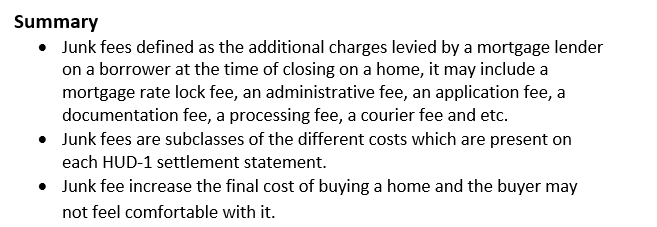What are Junk Fees?
Junk fees refer to different kind of charges that are applied by the lender on the borrower at the time of closing of a mortgage. Most of the time, these charges are not expected by the borrower or not in the knowledge of a borrower and not properly described by the lender. These unknown factors are the reasons that these charges are considered as unnecessary and
imposed in the legal closing costs without an appropriate reason.

Copyright © 2021 Kalkine Media
Understanding Junk Fees
Junk fees defined as the additional charges levied by a mortgage lender on a borrower at the time of closing on a home. When a mortgage is closing borrower is expecting to pay some closing costs. Although there are various extra or unnecessary charges that are imposed by a lender. Junk fees may include a mortgage rate lock fee, an administrative fee, an application fee, a documentation fee, a processing fee, a courier fee, and others. These fees may show the actual work that was completed; they incline to be basic services that are expected to give by a lender.
Junk fees are the kind of fees which are generally small and not clearly mentioned to the borrower until the time of closing the mortgage as it is a point where the borrower is very likely to accept and pay the charges. These kinds of fees frequently just fill the bottom line of a lender or loan originator. Junk fees are a Junk fees are subclasses of the different costs which are present on each HUD-1 settlement statement. Generally, HUD-1 settlement statement was an independent form that federal law needed a lender to give a borrower at the time of closing. The statement consists detailed information about all the costs related with the loan. Before closing, when both the parties are agreed with all the terms and conditions of the loan and start preparing for the closing, at that point a lender was needed to give a good faith estimate of all these costs.
In 2015, the Consumer Financial Protection Bureau made a single form by combining these documents, the closing disclosure. All the costs that are presented in the HUD-1 settlement statement range from boilerplate items including title search fees and home inspection, and the latter group may contain fee like an application fee, a verification of employment fee, an automated underwriting fee, document preparation fee, a sign-up fee, a funding fee, or a translation fee.
The borrower has the right to question these fees and can negotiate them with the lender, but most of the lenders believe that it is profitable because they believe and assume that the borrowers will fail to question these costs. The result of the Junk fees is that it increases the price of purchasing a home or sometimes it is not in the cost plan budget of a homebuyer. Junk fees increase the final cost of buying a home and the buyer may not feel comfortable with it.
Frequently Asked Questions (FAQs)
How Consumer Financial Protection Bureau (CFPB) is associated with Junk Fees
The junk fees may include different costs which are present on each HUD-1 settlement statement. In 2015, the Consumer Financial Protection Bureau made a single form by combining these documents, the closing disclosure. The bureau makes the changes in the closing process not only for smoothening the paperwork related to the closing process, but CFPB also put limitations on fees and adjustments that could be made after the good faith estimate (GFE) gave to the borrower.
One of the motives of CFPB to make these changes was to reduce the ability of the lenders to add junk fees that the buyer or borrowers might miss. The CFPB established a vital change in this new set of rules is that the restriction on the permitted inflation of charges recorded on the lending estimate, which is the formerly called as the good faith estimate (GFE). Usually, no fee can be imposed above 10% from the lending estimate to the final closing statement.
If major changes are occurred in the state affairs of the loan, the lenders have to allow the borrower to check new lending estimate as the limitations established by the CFPB may no longer applicable. These fees are not illegal, even with the bureau’s efforts of protecting the borrowers from the misleading lending practices; the borrowers carry the burden of careful examining and questioning fees which generate unnecessary.
 Please wait processing your request...
Please wait processing your request...